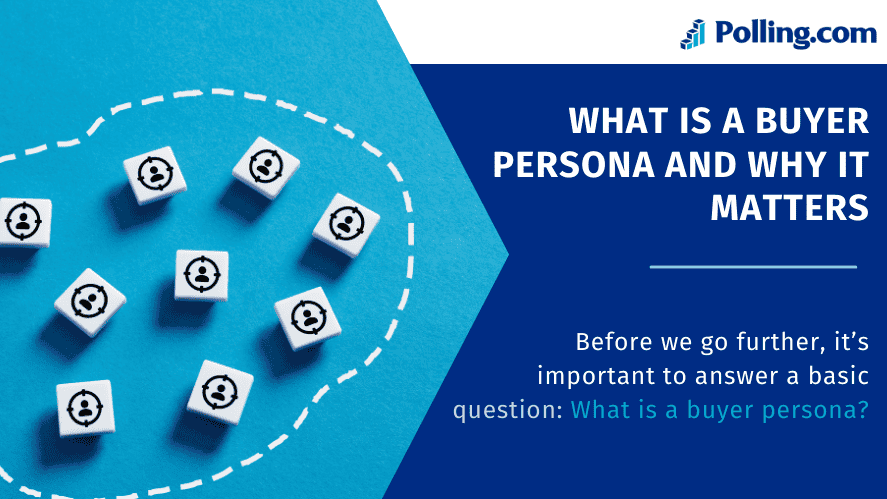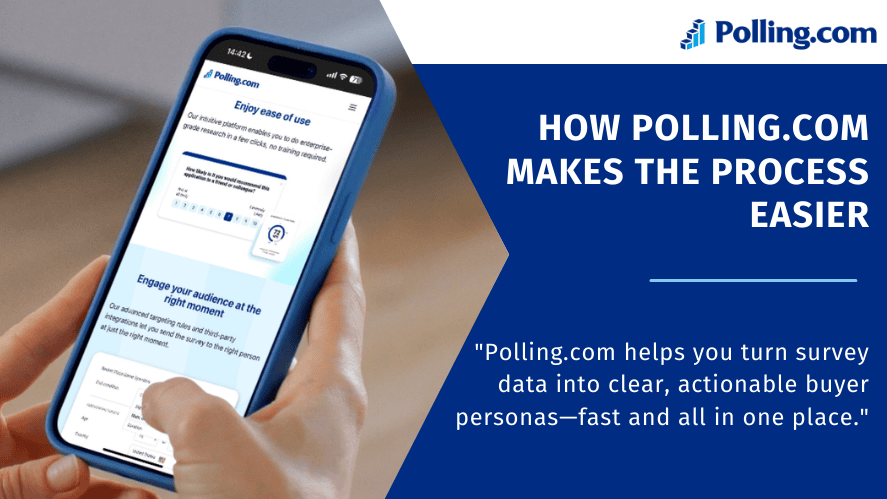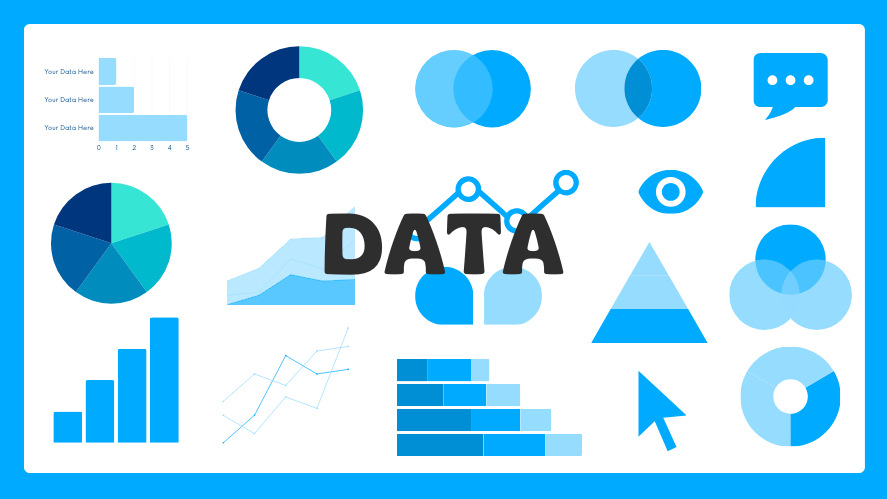
How Buyer Persona Development Boosts Survey Insights and Marketing ROI
Buyer persona development is more than a marketing buzzword. It is a proven method to increase the power of surveys and raise the return on marketing efforts. When you create clear profiles of your ideal customers, every part of your business gets stronger.
But how exactly do buyer personas make surveys smarter and marketing more profitable? In this complete guide, you’ll learn what buyer personas are, how to build them step by step, and how platforms like Polling.com help you gather the data you need.
Let’s begin by understanding the basics.
What Is a Buyer Persona and Why It Matters

Buyer Persona Defined
A buyer persona is a detailed and researched profile that describes your ideal customer. It includes facts like age, job title, goals, challenges, buying habits, and preferences.
Sometimes, you may hear terms like customer persona, target audience profile, or sample target audience profile. These are all similar. They each describe a type of person who is likely to buy from you.
For example, imagine your product is a marketing tool. Instead of saying your audience is “marketers,” a buyer persona would describe a person like this:
- Name: Marketing Mary
- Age: 34
- Job Title: Digital Marketing Manager
- Goals: Generate more leads through paid ads
- Challenges: Small team, tight deadlines
- Preferred Channels: LinkedIn, YouTube, Email
Clearly, this persona provides more than just a job title. It helps you understand the real person behind the screen.
Why Buyer Persona Development Is Critical
Now that you understand what a persona is, you might ask, why go through the process of developing a buyer persona?
Here are several important reasons:
- Smarter Survey Design When you know who you’re asking, you can write better questions. As a result, responses are more accurate and useful.
- Better Marketing Targeting When messaging aligns with real needs and goals, customers are more likely to respond. Therefore, your ads, emails, and content perform better.
- Clearer Audience Segmentation Personas help you divide your audience into meaningful groups. Each group can receive messages that fit their unique challenges.
- Higher Return on Investment (ROI) With personas guiding your actions, you waste less money and time. In turn, your marketing becomes more efficient and effective.
How Polling.com Makes the Process Easier

Tools like Polling.com are built to support buyer persona development. For example, you can launch targeted surveys, analyze answers by customer type, and build dashboards that help you see clear patterns.
Using Polling.com survey insights, your team can stop guessing and start building strategies based on facts.
The Key Components of an Effective Buyer Persona
Building a persona is not just about guessing what your customer looks like. Instead, it involves collecting different types of data to create a full picture.
Here are the four core components of a strong persona.
1. Demographics
Demographic data includes things like:
- Age
- Gender
- Income
- Education
- Location
- Job title
- Industry
This information helps you understand the basics of who your customers are.
2. Psychographics
Psychographics focus on how people think and feel. These include:
- Personal goals
- Values and beliefs
- Common frustrations
- Motivation for buying
When you understand why people act a certain way, you can adjust your messaging to fit their mindset.
3. Behavioral Traits
Next, look at how your customers behave:
- Do they prefer to buy online or in person?
- What kind of content do they consume?
- How often do they purchase?
Knowing these patterns helps you decide where and how to reach them.
4. Buying Triggers
Finally, consider what causes someone to take action:
- What problems lead them to search for a solution?
- What makes them trust a brand?
- What objections do they usually have?
Understanding these triggers allows you to guide them smoothly through the decision-making process.
Example: A Buyer Persona Template for Polling and Insights
Let’s walk through a sample persona you can build using Polling.com audience research:
Name: Startup Sarah
Age: 29
Job Title: Founder of a fintech startup
Location: New York City
Income: $95,000
Goals: Launch a product fast and attract users
Challenges: Small team, little time, tight budget
Buying Behavior: Prefers tools with automation and easy onboarding
Survey Preferences: Mobile-friendly, quick answers, no fluff
You can use a buyer persona template for polling and insights to create Sarah’s profile and test your messaging using Polling.com.
Step-by-Step Process for Buyer Persona Development

Now that you know what a persona is, you might wonder how to build one. Below is a simple process that shows how to build a buyer persona step by step.
Step 1: Gather Data from Surveys and Analytics
Start with the data you already have. For example:
- Run surveys with Polling.com to ask about customer goals and challenges
- Review your website and email analytics
- Study your CRM for past purchase behavior
- Listen to comments and reviews on social media
As you collect this data, look for common answers. These patterns will guide your persona creation.
Step 2: Do Qualitative Research
In addition to surveys, conduct interviews or small focus groups. Ask open questions like:
- What was your goal when you started looking for a product like ours?
- What nearly stopped you from choosing us?
- What helped you make your final decision?
These conversations provide the emotional and motivational details that numbers alone can’t show.
Step 3: Segment Your Audience
Once you have the data, begin to group your audience based on similarities. For example:
- Shared frustrations
- Similar job roles
- Matching goals
- Common budget range
This process is called audience segmentation. It helps you decide which groups deserve their own persona.
Step 4: Create the Persona Profiles
Now it’s time to write clear profiles. Each persona should include:
- Name and short story
- Age, job title, and location
- Goals, pain points, and motivations
- Buying behavior
- Preferred communication channels
Additionally, use Polling.com to test these personas. For example, ask your survey participants, “Which of these statements feels most like you?” Their answers will help you confirm if your persona is realistic.
Step 5: Apply Personas Across Surveys and Marketing
Next, start using your personas to guide actions.
- Write survey questions using the tone and language that fits each persona
- Segment email lists so each group gets content that fits their needs
- Design landing pages that match persona goals and pain points
- Use Polling.com filters to sort feedback by persona group
When you apply personas in this way, you create a better experience for each audience type.
Step 6: Review and Update Often
Personas are never final. Over time, your market changes, new features are added, and customer behavior shifts.
Therefore, check your personas every 6 to 12 months. Use fresh Polling.com survey insights to look for new trends or shifts in goals.
Updating personas keeps your marketing and research current.
How to Use Buyer Personas in Surveys and Marketing
Once your personas are ready, you should apply them in your campaigns and research. Here’s how.
Personalize Survey Design

First, align your survey with each persona’s language, tone, and preferences. For instance:
- Use casual language for startups
- Use data-driven terms for technical buyers
- Keep surveys short for time-pressed users
As a result, you’ll improve completion rates and gather better data.
Segment Survey Responses
Then, break your survey responses into groups. Polling.com makes this simple with built-in filters.
For example, you might discover that:
- Tech-Savvy Tom cares about API access
- Budget-Conscious Beth wants better onboarding
- Creative Carla prefers visual dashboards
This level of detail makes your follow-up actions more effective.
Use Persona Data in Campaigns
Now that you know what each persona values, build targeted content.
- Write blogs that answer their biggest questions
- Run ads that reflect their goals
- Create email sequences that guide them step-by-step
In addition, use survey feedback to support your messaging with real quotes or stats.
Common Mistakes in Buyer Persona Development and How to Avoid Them
Even with good intentions, many companies make mistakes when creating and using personas. However, knowing these mistakes in advance can help you avoid wasted effort and missed results.
Let’s go over the most common ones.
Mistake 1: Building Personas Without Real Data
Some businesses create personas based on guesswork. They imagine what their customers want instead of asking them directly.

What to do instead: Use real data from surveys, interviews, and platforms like Polling.com audience research. For instance, gather insights from actual users who have interacted with your brand.
As a result, your personas will reflect actual customer behavior, not just opinions.
Mistake 2: Having Too Many or Too Few Personas
Another mistake is creating too many personas, which becomes hard to manage. On the other hand, too few personas don’t capture enough variety in your audience.
What to do instead: Start with three to five personas that represent your main customer types. Then, expand only if new segments clearly appear in your data.
By focusing on quality over quantity, you make sure your personas remain useful.
Mistake 3: Ignoring Updates
Some companies treat personas like a one-time project. However, customer needs and behavior change over time.
What to do instead: Review your personas every six months. In addition, use new Polling.com survey insights to keep them fresh.
This way, your marketing and product decisions stay aligned with the current audience.
Mistake 4: Not Using Personas in Daily Work
Sometimes, personas are created but never used. They stay in a slide deck and are forgotten.
What to do instead: Share your personas with every team. For example, marketers can write better ads, sales teams can change their pitch, and product teams can adjust their roadmap.
When everyone uses the same customer understanding, the entire customer experience improves.
Case Study: A SaaS Company Uses Personas to Boost Survey and Marketing Results
Now let’s look at a real-world example that shows the impact of buyer persona development using Polling.com.
The Problem
Company: TaskFlow CRM
Industry: B2B SaaS
Issue: Poor survey response rates and unclear customer segments
The marketing team was unsure who they were targeting. As a result, content and ads were not performing well. Furthermore, the product team didn’t know which features to prioritize.
The Solution
They turned to Polling.com to run detailed surveys and segment responses by type.
First, they asked questions like:
- What is your main reason for using our product?
- What problems were you hoping to solve?
- What features do you use most often?
Next, they grouped the responses into two main personas.
The Personas
Tech-Savvy Tom
- Role: IT Manager at a fast-growing company
- Goal: Automate workflows
- Challenge: Needs strong integration features
- Behavior: Prefers detailed documentation and APIs
Budget-Conscious Beth
- Role: Admin at a small nonprofit
- Goal: Keep costs low
- Challenge: Limited training time
- Behavior: Responds to simple tools and onboarding support
Each persona was linked to real survey answers. Therefore, their needs were clear and backed by data.
The Changes
After building these personas, the team took several steps:
- Redesigned surveys with questions matched to each persona
- Launched targeted ad campaigns with persona-specific messages
- Created blog posts and product guides for each group
- Used Polling.com to filter feedback by persona
These actions led to more targeted communication and smarter marketing choices.
The Results
Within 90 days, TaskFlow saw major improvements:
- Survey response rate increased by 42%
- Email open rates rose by 28%
- Conversions from ads improved by 21%
- Product usage satisfaction scores went up across both persona groups
As a result, teams felt more confident about their decisions, and customers received a better experience.
Measuring the Success of Your Buyer Persona Strategy
Once your personas are active, it’s important to track how well they are working. Fortunately, there are many clear ways to do this.
1. Survey Metrics
First, look at how your surveys perform for each persona.
- Are completion rates increasing?
- Are open-ended answers more detailed?
- Are you seeing fewer skipped questions?
By tracking these points with Polling.com, you can tell if your surveys feel relevant to your audience.
2. Marketing and Content Metrics
Next, review how each persona responds to your marketing.
- Do emails have higher open and click rates?
- Are ad campaigns for each persona converting better?
- Does content engagement vary by persona group?
The more aligned your messaging is, the more these numbers will improve.
3. Customer Experience Metrics
Finally, look at the full customer journey.
- Is retention better for some personas?
- Do certain groups need more support?
- Is satisfaction improving overall?
Using Polling.com survey insights, you can connect this feedback to each persona. As a result, you will see what’s working and what needs to be fixed.
Conclusion: Put Buyer Persona Development into Action
To sum up, buyer persona development helps you get closer to your customers. Instead of guessing, you make choices based on real needs, behaviors, and motivations.
When used properly, personas will:
- Make your surveys more focused
- Help your teams understand the audience better
- Increase the impact of your marketing
- Improve how you develop products
- Raise your return on investment
Most importantly, personas give your team a shared language for understanding the customer.
By using tools like Polling.com, you can create and update personas based on live survey data. This keeps your insights fresh, your campaigns relevant, and your results consistent.
Your Next Step
If you’re ready to build or improve your personas, launch a survey today with a Polling.com survey template. The faster you collect accurate data, the sooner you can build profiles that work.
Start today, and transform how your team understands and connects with your audience.
